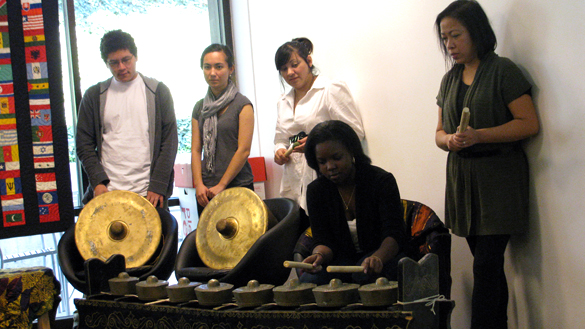Students at California State University, Dominguez Hills regularly have the opportunity to learn about the world’s variety of cultures through academic coursework, special events on campus, and simply by attending one of the most diverse universities in the nation. But often, these students are surprised by what they end up learning about their own ethnic heritage, which their families may not have shared with them, or known about themselves.

Humanities lecturer Mary Talusan Lacanlale says that Filipino American students in her HUM310 Global Popular Music class are often not aware of the multicultural aspects of the Philippines, a polyglot culture composed of elements from indigenous culture and the influence of Spanish, Asian, and American occupation and trade. In recognition of October as Filipino History Month, she presented a workshop on Oct. 5 in the university’s Multicultural Center on kulintang, a brass gong ensemble from the southern island of Mindanao, a region of the Philippines that has a significant Muslim presence.
“Many Filipino Americans are aware that the Philippines has a Muslim minority, but not many know anything about their indigenous music or traditions. [Kulintang is] the coolest thing–these are gongs and drums, and they are really percussive and syncopated.”
Talusan Lacanlale did extensive research on the genre under Danongan Kalanduyan, one of only two native Filipino kulintang masters in the United States, and the only Filipino American to be awarded a National Endowment for the Arts National Heritage Fellowship. She says that traveling to Mindanao to do research on the origins of kulintang and Kalanduyan’s fellow musicians was inspiring.
“I learned that having a tradition like this is so important to their sense of identity,” says Talusan Lacanlale. “This is our music, they would say. No matter how poor the Muslim Filipinos I met were or how devastated their communities were because of war and violence, they were always so proud of their cultural traditions.”
Talusan Lacanlale, who earned her master’s and doctorate degrees in ethnomusicology at UCLA, also plays the erhu, a two-stringed Chinese instrument and Indonesian gamelan, which also features brass gongs as well as xylophones, bamboo flutes, and stringed instruments. She incorporates these techniques, as well as her classical training in piano and cello, into her humanities courses at CSU Dominguez Hills and Loyola Marymount University, and says that family history inspired her to teach and share world cultures through music.
“I analyze things like race and colonialism through music history,” Talusan Lacanlale says. “I have a great-grandfather, who I’m writing a book about, who came to the U.S. in 1904 as part of this military brass band. This military band was sent to tour America during a time when the U.S. was highly criticized for colonizing the Philippines. By sending this talented Filipino band to the States, U.S. officials wanted to say ‘Look at all the great things we taught them.’ However, Filipinos had been playing European music for three centuries before the U.S. arrived. Furthermore, the leader of this band was an African American officer named Walter H. Loving, so it’s a really complicated story!”
Talusan Lacanlale has performed and recorded kulintang performances with members of the Pakaraguian Kulintang Ensemble for Apl.de.Ap of the Black Eyed Peas; the Filipino-African American artist wanted traditional instrumentals for his upcoming solo album. She hopes that her students will learn that popular music around the world goes beyond mere entertainment and has so much to do with the cultural, political and social forces that shape it.
“A rock song can express the spirit of a social movement,” says Talusan Lacanlale. “For example, the first rock star in China named Cui Jian became the voice of the Tiananmen Square movement. Also, if you think about the Civil Rights movement in this country, you have to [consider] the music and musicians involved. Popular music has been a catalyst for social change and an important way for people around the world express their identities. We did a [lesson on] how heavy metal went global, and how different cultures interpret and transform heavy metal music. They all add something new and unique to this global genre.”
Talusan Lacanlale also hopes that students from all ethnic origins take the importance of community participation away from events like her kulintang workshop, during which she taught each student how to play an instrument and then had them teach the technique to another student, which culminated in impromptu performances.
“That’s how music becomes transmitted from one person to the next,” says Talusan Lacanlale. “Playing in a group like that is about cooperation, participation, respect, and creativity.”
Talusan Lacanlale co-produced the inaugural “Pilipino Americans Got Talent,” a talent show to celebrate the large Filipino American population of the city of Carson.
The program, in conjunction with month-long cultural exhibits, took place at the South Bay Pavilion on Oct. 29.
– Updated on Oct. 31